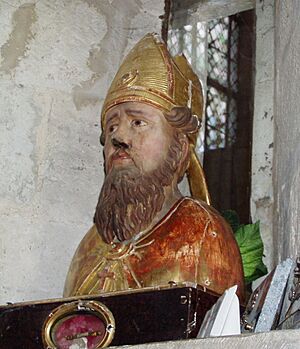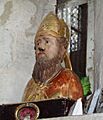Sulpitius the Pious facts for kids
Quick facts for kids SaintSulpitius the Pious |
|
|---|---|

Reliquary bust of Saint Sulpitius the Pious. Church of Saint-Sulpice-de-Favières.
|
|
| Bishop, Monastery founder | |
| Born | c.570 Vatan, Francia |
| Died | 17 January 646 Bourges |
| Venerated in | Catholic Church Eastern Orthodox Church |
| Major shrine | Saint-Sulpice, Paris |
| Feast | 17 January |
| Patronage | Vatan, Bourges, late vocations priests, patients with: pains, gout and skin condition |
Sulpitius the Pious (died January 17, 646) was an important leader in the Christian church during the 600s. He served as a bishop in the city of Bourges, which is in modern-day France. He is also recognized as a saint by the Catholic and Eastern Orthodox Churches.
Contents
Who Was Sulpitius the Pious?
Sulpitius was born around the year 570 in a town called Vatan, near Bourges. His family was wealthy and well-known. From a young age, Sulpitius was very religious. He spent his time helping others and studying the Bible. He even gave away his family's large fortune to the Church and to people in need.
Becoming a Church Leader
The Bishop of Bourges, Austregisilus, noticed Sulpitius's dedication. He first made Sulpitius a cleric, which is a church official. Then, Sulpitius became a deacon, a helper to the priests. Finally, he was put in charge of the bishop's school.
King Clotaire II, who ruled the Franks (an ancient Germanic people), heard about Sulpitius's good qualities. The king invited Sulpitius to join his royal court. There, Sulpitius became the king's almoner, someone who gives money to the poor. He also served as a chaplain for the king's armies.
Sulpitius as Bishop of Bourges
Around the year 624, Bishop Austregisilus passed away. Sulpitius was then called back to Bourges to take his place as bishop. As bishop, he worked hard to bring order back to the church. He also focused on helping the poor people in his community.
In 627, Sulpitius attended an important meeting called the Council of Clichy. He also held other meetings with bishops from his region. He was good friends with Saint Desiderius of Cahors, who was a treasurer for King Clotaire II.
Helping His Community
Sulpitius was known for standing up for his people. The king's representative, General Lollo, was sent to Bourges. He was collecting very high taxes from the people. When the citizens complained to Sulpitius, he took action.
Sulpitius asked all the clergy (church leaders) and regular people to fast for three days. He also sent one of his own church members, Ebargisilus, to talk to the king. Because of Sulpitius's efforts, the king agreed to lower the taxes.
Later Life and Death
Towards the end of his life, Sulpitius chose a helper named Vulfoleudus. This allowed Sulpitius to retire to a monastery he had built near Bourges. A monastery is a place where monks live and dedicate their lives to religious practice.
Sulpitius died on January 17, 646. Many people believed he was a saint. Soon after his death, people reported miracles happening at his tomb. His burial place became a popular spot for pilgrimages, where people travel for religious reasons.
Sulpitius's Lasting Impact
Sulpitius the Pious left a significant mark on history. A famous church in Paris, called Saint-Sulpice, was built in his honor. A religious group, the Society of Saint-Sulpice, also takes its name from him.
The story of Sulpitius's life also includes the story of another saint, Eustadiola.
When Is Sulpitius Remembered?
Sulpitius the Pious is remembered on several days throughout the year:
- January 17 – This is his main commemoration day, marking the anniversary of his death.
- January 18 – This day is his main commemoration in the Mozarabic Rite, an old Christian tradition.
- January 19 – Another day for his main commemoration.
- August 27 – This day marks when his holy remains were moved from Bourges to Vatan in 1757.
Images for kids


